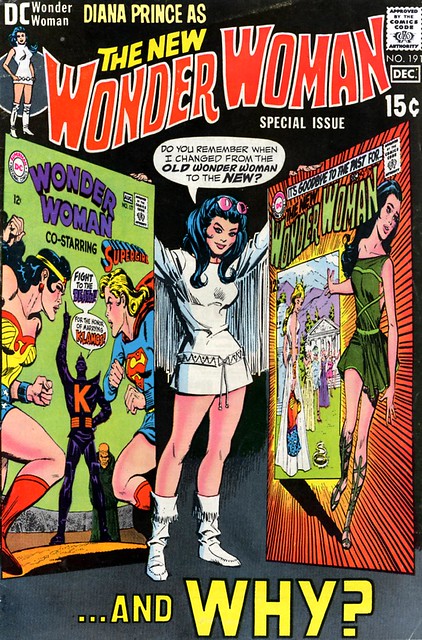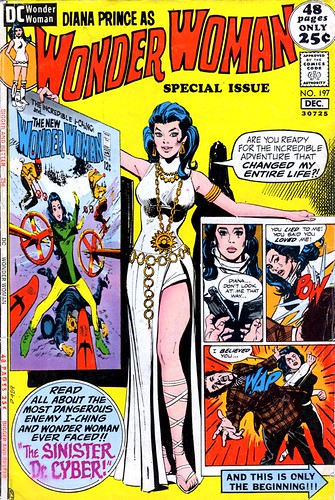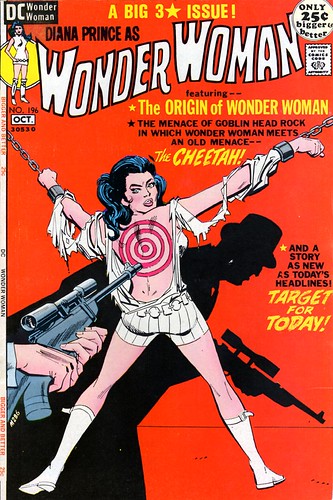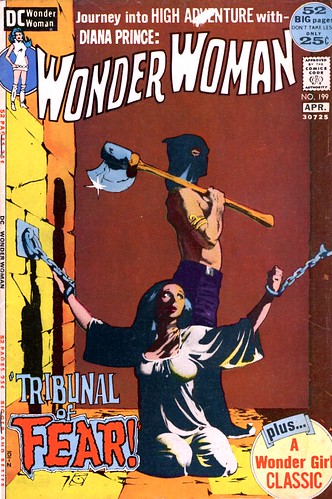Introducing the NEW Wonder Woman, circa 1968! You didn’t think I actually meant Adrianne Palicki, did you? The firestorm that erupted over ABC’s latest Wonder Woman and her Frederick’s of Hollywood costume somehow put my mind back to this incarnation of Diana Prince. Imagine the internet firestorm that would have erupted in today’s marketplace if Mike Sekowsky and Denny O’Neill stripped the character of her super-powers, costume, and Justice League membership. Diana Price became a Modesty Blaise type of character, traveling around the world with I-Ching and battling bad guys with martial arts instead of bracelets and magic lassos. My very first Wonder Woman comic that I ever bought featured the “new” version, while I still read the costumed WW in Justice League of America Giant reprints. The differences between the two didn’t bother me at all—I could tell that these tales were happening at two different eras.
There have been many articles written about the Diana Prince era, so I won’t recap the history here. After perusing the comics for this article, they offered a lot more creativity and goofy fun than I remembered. It makes me wonder if the new TV show should have considered using the look and some of the ideas here. I think Wonder Woman, in the comics, works as a visual icon (great for merchandising), but fundamentally she is a flawed character. WW was created by William Moulton Marston to bring a female superhero into comics—a good intention—but Marston was also expressing some mature sexual themes (bondage, S&M, etc) in the strip. WW comes from an island inhabited by women where no men are allowed—but lesbianism is never discussed. WW represents female liberation, but her costume has shrunk throughout the ages—today she dresses like a Maxim model. She has super-powers and a Justice League membership, but doesn’t have a solid supporting cast and no life outside of being a super-hero. Any attempt to bring Wonder Woman into TV or movies must do something to fix these problems for a modern audience. The 1968 era Wonder Woman at least put her in different clothes and gave her a buddy to share adventures with. There were nice romantic sub-plots as well, and it was great to see them jettison Steve Trevor. I always hated Steve Trevor with a passion. I couldn’t imagine why Wonder Woman would pine for that clown when she would have had more in common with Superman, Batman, or even Aquaman.
However, even with the New Wonder Woman, the editors resorted to old tricks, by putting Diana in bondage scenes on the covers. Issue 196 from 1971 stands out in my memory as a shocking cover for a kid to see: Diana’s shirt torn, a target painted on the back, while she is bound, utterly helpless in chains. I remember buying this just to see what would happen next, so that cover worked, but it is interesting that Marston’s Id always finds a way to return to the character.
Three issues later, DC again put Diana in chains, but this time they had Jeffrey Jones, a contemporary of Berni Wrightson and Barry Smith, to do the cover. I remember this particular issue fetching a slightly higher back issue price for a time, since Jones did few covers and he made this one look more like a gothic horror cover.
As controversial as the New Wonder Woman became in comics history, it was definitely interesting to me as a young reader. I remember that I bought almost all these issues featuring Diana Prince, but oddly enough, when she went back to her old star spangled costume in 1973, I stopped buying the series completely. The Diana Prince version seemed daring and different, in the same vein as Green Lantern / Green Arrow, the new Supergirl, the modern Lois Lane, and the new era of Batman. When Diana returned to her old costume, it seemed like a giant step backward. I’m crazy, I know, but when Diana went back, the creative team changed and the stories just seemed old fashioned and dull. It would take George Perez to get me interested in a superhero type Wonder Woman after Crisis on Infinite Earths. Nuff Said!





No comments:
Post a Comment